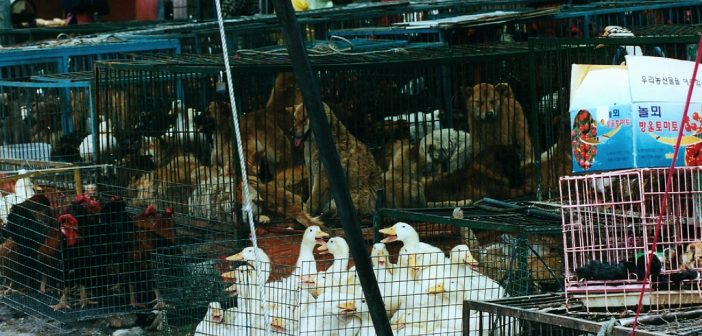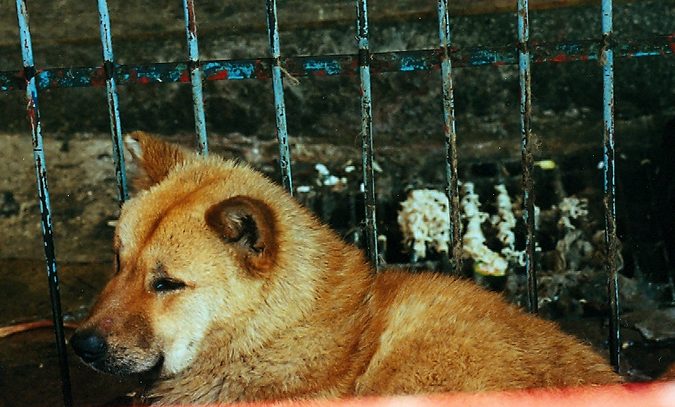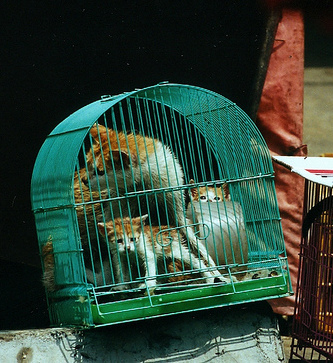(Featured image: dogs, cats, chickens, and ducks all awaiting slaughter in Moran Market, Seongnam, South Korea. Photo by Kim Bartlett)
What makes dog-eating and cat-eating some degrees worse than eating more typical farm animals is the extra amount of cruelty involved in slaughtering them because, unlike the more docile domesticated animals, they are capable of fighting back when someone tries to kill them, and so some extra procedure is performed to render dogs harmless. For example, tin cans tied over the muzzle and legs bent and tied behind their bodies, or nooses placed around dogs’ necks to hang or partially hang them during slaughter; or in the case of cats, they are often held around the neck with long tongs and dropped live into large vats of boiling water, or they may have been hammered on the forehead in a crude form of lobotomy so that they don’t resist being handled and killed. Dogs are often electrocuted or hung.
Many are purposely tortured to death by slow beatings, strangulation, and/or burning, because of a belief that the meat will taste better or have increased medicinal value as treatment for male erectile dysfunction.
Traders in dogs and cats for meat prefer former companion animals, because they are easy to handle, and fight less than feral cats and dogs, and so the trade encourages criminal theft of owned pets.

Ducks for sale alongside cats packed into a cage, at Moran Market in South Korea (photo by Kim Bartlett)
The moral objection to dog or cat eating should not be that dogs and cats (supposedly unlike farm animals more typically eaten in Western countries) are pets, companion animals, or friends. The truth is that pigs, lambs, cows, and even chickens may be equal or superior in intellect and in ability to feel pain or suffer, and they are equally friendly towards people if their companionship is welcomed. All animals would prefer to be our friends rather than our food.
Photos are widely forwarded of dogs and cats crammed into cages on trucks enroute to meat markets, and viewers of the photos are justifiably outraged, but pigs, sheep, cattle, poultry, horses, etc. are frequently transported in similarly miserable conditions.
Anti-dog meat campaigns are very active in Thailand, where people who don’t eat dogs may capture dogs illegally and truck them into Chinese or Vietnamese provinces where dogs are eaten. The greatest number of dogs are eaten in China, while cats are eaten mainly in the Guangdong province of south China. The pelts of the dogs and cats eaten in China are sold to the fur trade.
Dogs are also eaten in parts of Burma, the mountainous regions of Laos, and in the northeast of India.
Many dogs are eaten in Korea.
Huge numbers of dogs are eaten in sub-Saharan Africa.
It is worth noting that dogs may be treated no better in parts of Europe, such as Ukraine or Greece, where they may not be eaten but are killed barbarically so that their skins may be used for furs. In what seems an aberration in western Europe, there is a cottage cat fur industry in a region of Switzerland where people also use cat meat in traditional recipes.
When people – mainly Westerners – tell Asians and members of other racial or ethnic groups who eat dogs that they shouldn’t do so, they say what about all the animals Westerners are eating? If you say dogs are supposed to be pet animals, they will say that they have some dogs for pets and some dogs for eating.
The whole meat issue is trivialized when it becomes about which animals are appropriate for eating and which are taboo. The legitimate way to focus campaigns against the dog and cat meat trades in Asia and elsewhere is to point out the additional cruelty involved in handling and killing those species, with attention to the criminal theft of pet dogs and pet cats.
Raising the specter of rabies that may be transmitted by cat and dog bites, or spread by the conveyance of large numbers of dogs and cats from one area to another, has helped to increase concern about the dog and cat meat trade among public health officials in southeast Asia, and thus is a valuable approach. However, serious and potentially zoonotic diseases are caused and spread by the trade and/or consumption of every other species. This includes the annual global influenza epidemics that originate in Guangdong, avian flu, swine fever, SARS, ebola, mad cow disease, hepatitis, etc.
The higher level of cruelty is the only reason for having a campaign specifically against the dog and cat meat trades in Asia or Africa. Otherwise, an animal welfare campaign should call for reform in how all animals turned into meat are handled and butchered, and an animal rights campaign should work against the eating all animals. If the result of an anti-dog-meat or anti-cat-meat campaign is to make people feel that it’s better to eat pigs and other animals, then it’s a case of winning a battle but losing the war.
I say this as a person with a lifelong attachment to dogs and cats. However, I have been involved in animal protection since 1972 and a vegetarian since 1983.
In 2000, I went to South Korea to photograph Seoul’s notorious Moran Market, a live market that specializes in selling dog and cat meat, but also sells live rabbits, ducks, chickens, reptiles, fish, and amphibians – all killed horrifically. For example, the dogs (mostly Jindo dogs but also representatives of Western breeds, memorably including a Dalmation and a quivering and drooling Jack Russell terrier) were dragged with nooses out of cages to be electrocuted; rabbits were hung and disemboweled while fully conscious; and cats in cages in the hot sun were taken out with tongs and dropped into large vats of boiling water. Cats in the larger cages were mostly already dead of heat stroke, thirst, starvation, or from the neurological effects of being lobotomized with hammer blows (depressions made in the cats’ foreheads by hammers were quite visible and unmistakable). The still living cats in the large cages were on top of layers of dead cats, the bottom layer of bodies being quite decomposed.
I had prepared myself for days so that I could bear up to what I knew I’d see. I took numerous rolls of film and managed to keep them all, in spite of thugs employed by the market attempting to snatch the film each time I reloaded my camera. Our Korean guide, Kyenan Kum of International Aid to Korean Animals, had told us the thugs were dangerous, but at that point, I was fearless and feelingless… until I made the mistake of making eye contact with a mother cat and her three kittens who were being held in a birdcage. Then I began to cry, and, very strangely, the market workers – most of whom were women – who had laughed at and mocked me and my concern for the animals, became silent and sympathetic.
After we left the market premises, I asked Kyenan if we could purchase and rescue the mother cat and kittens, but she said it would be a mistake to buy any animals. After seeing what has happened at the Yulin dog festival in China, with dogs being threatened with extra brutality if activists didn’t buy them, I believe Kyenan was correct. Yet the image of the cat and her kittens, and also the Jack Russell terrier who was quaking with fear, are burned into my memory and they will be with me in my heart as long as I live.
But the mission of animal advocacy is to fight on behalf of all living creatures, and not to serve the best interests of animals with whom we may have a special bond by betraying the greater number of other animals.








3 Comments
Stop for meat the dog and cat place
While I would agree with what you are saying for the most part Kim, I have to say that Dogs are in a class of heir own. Don’t get me wrong I’m vegetarian and don’t believe in the slaughter of any animal. But the dog contributes more to mankind than any other animal, maybe even more than all other animals combine. Dogs are our protectors, they lead the blind, comfort the elderly and dying children, they sniff out explosives and drugs to keep our borders safe, they find survivors in the rubble after an earthquake, even go to war! There have been dogs who can locate cancer and infection in people they are a source of transportation in the Arctic pulling sleds. The list goes on and on, hence Man’s best friend. These are no special breed they just need TLC and training. So treating them so harshly and yes the torture is unforgivable in my eyes. You don’t treat them with such disrespect when they give so much.
I’m actually shocked by your insinuation that farm animals intelligence or pain sensation is superior to that of a canine. Also as a veternarian i am sure you are aware that canines have been designed by man over thousands of years to be companion and protector to man. We have purposely bred traits so that the bond between man and dog is far superior than that of other creatures. Dogs are companion animals social and intelligent. MRI of canines show areas of activity light up in response to their person. Canines will work and defend and protect to the death. WhileI do not condone any act of animal cruelty and I do not consume meat the manner in which these dogs are tortured is especially heinous and the consumption is not for food it is for mythical medicinal benefits to ward of heat of the summer. Your posting is at best misleading and misguided.